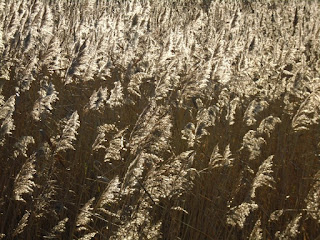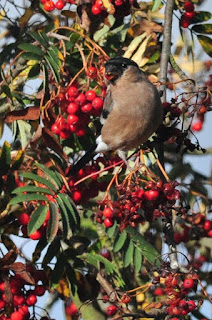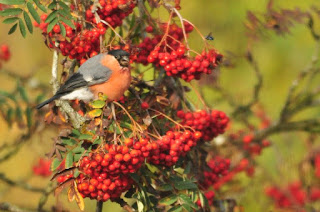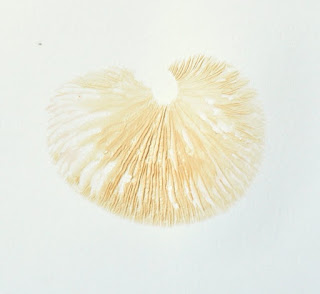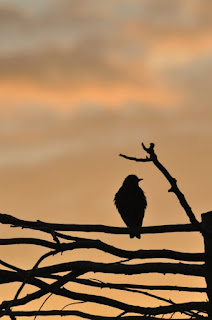Being the bird nerd that I am, I keep a list of all the birds I see or hear from the house or garden each year, and that list usually reaches the mid-fifties (my best was 58 species, last year). There are birds I see every day (house sparrow, blue tit, chaffinch, dunnock, woodpigeon, blackbird, robin etc), birds that I see regularly but less frequently (great spotted woodpecker, goldfinch, jackdaw, stock dove), birds I know I'll see in the summer (swallow, house martin, chiffchaff etc) and in the winter (redwing etc). Some I might only see once or twice in the year (red kite, grey heron etc). Sometimes something much more unusual turns up (yellow-browed warbler), you just never know...
One thing I do know, however, is that having a rowan tree at the end of the drive mightily increases the chance of me seeing lots of birds! It attracts warblers, finches and tits in the spring and summer (searching for insects/caterpillars and the like), but it really comes into its own in the autumn and winter. This year it is absolutely loaded with berries (check out the photo of the redwing, below, which I took in November 2015 - no leaves and far fewer berries than this year). The birds are making the most of the feast.
So far this winter I've seen: blackbird, song thrush, starling, redwing, mistle thrush, fieldfare, chaffinch, greenfinch, goldfinch, bullfinch, blackcap, woodpigeon and robin (eating fallen berries from the ground).
I've noticed different feeding patterns - bullfinches, often in a group, will sit and feed for long periods (all morning it seems, if they aren't disturbed!), whereas starlings are 'smash and grab' artists, descending, grabbing a few berries, then flying off within a few seconds.
Rowan trees (aka Mountain Ash and Witch wiggin tree, among other names) were once planted near houses as protection against witches, but these days you are at least as likely to find them in supermarket car parks or lining the suburban streets. The rowan tree at the end of our driveway was planted by my partner's mum, when the family first moved here back in the 1970s. I'm not sure if she was mindful of witches when she planted the tree, but it's certainly a big draw for birdlife, so it keeps me happy!




